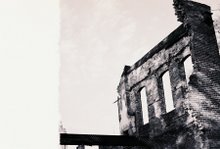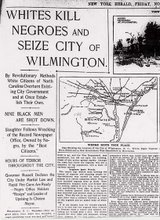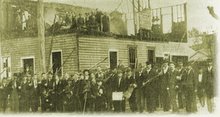The prioritized objective of this production project is not only to explore the historical fidelity and repugnance of the events surrounding the Wilmington race riots of 1898, but to also observe the disheartening consequences that reverberate throughout the community today. A popular, yet bewildering, sentiment amongst certain less-engaged, white southerners is that the racial crimes of the past are neatly sketched into history books with an obligatory tone of remorse, therefore they are wiped clean from our temporal reality. When addressed with issues such as affirmative-action or reparations, some individuals will respond with the rural cliche, "I didn't own slaves or run blacks out of town, so why should I have to pay?" Unfortunately, the reality is that the past is laced inseparably throughout our current racial relations and the socio-economic divide between races. In order to capture, or at least attempt, an honest inquiry into the 1898 Coup D'etat, we must explore the current reality of the African American community in Wilmington, NC.
As a production group, we will begin our motion film investigation by taking black & white, observational images with a 16 mm Bolex. We will work as a four man crew with divided responsibilities to capture spontaneous and hopefully unaffected images. The subject will be the African American communities of downtown Wilmington. Specifically, we will concentrate on the communities of Castle Street(South-side) and North Fourth Street. By taking an observational approach to the contemporary aspects of our research, we hope to attain a more realistic perspective than can be achieved through the analysis of statistics and scholarly data.
The content of the images will greatly depend on the randomness of occurrence. However, we have designed certain approaches and strategies to filming each atmosphere in order to capture a raw perspective without being intrusive or exploitative in regards to the individuals that live and work in the communities. We will observe the social and cultural realities of local residents and the physical atmosphere in which they live, including dilapidated structures, struggling local businesses, and homes. There is no doubt in our minds that the ensuing exploration will be dampened with sadness and possible resistance or discomfort, but there is also the potential of enlightening discoveries.
Subscribe to:
Post Comments (Atom)



No comments:
Post a Comment